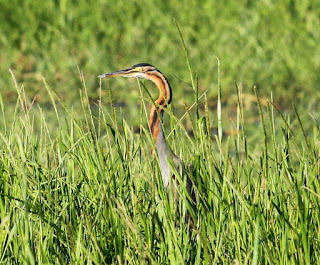The Resort: This comprises the narrower, eastern section of the island, surrounded by beaches. Around the resort wander Tabon Scrubfowl and Emerald Doves, quite undisturbed by people. The trees around the resort support a large population of Black-naped Orioles, Yellow-bellied Gerygones and Yellow-vented Bulbuls with smaller numbers of Pied Trillers and Olive-backed Sunbirds. Pied Fantails are in the lower branches, and at sunset Great-eared Nightjars hawk over the palm trees. On the beach around the resort we were privileged to watch a clutch of Hawksbill Turtles hatching on one special evening, and on one of the last nights we even saw a gigantic female building her nest. These fantastic reptiles are easily seen by divers here. Green Turtles also occur, and can be seen while snorkelling in the area with sea grass near the eastern tip of the island.
The Forest/ Plantation: To the west of the resort are several acres of coconut plantations, which gradually disappear into the forest. In the plantation area Lowland White-eyes are regular (not mentioned in Kennedy et al). Once the forest is reached birding becomes much more interesting. The larger fruit trees regularly sport several species of pigeon, including Green Imperial Pigeon, and my first Pied Imperial Pigeons in The Philippines. Other fruit-eating canopy birds included lots of Mindoro Bulbul, and elusive but very noisy Asian Koel. A Philippine Coucal showed itself very well one morning climbing through the understorey. Mangrove Flycatchers are quite common in this area too. On the ground Plain Bush-hen seemed to dominate though they were hard to photograph, the only other rallid I saw was a single Barred Rail. A juvenile Changeable Hawk-Eagle was a big surprise in the plantation on the first day. I saw it on two subsequent occasions, both in the forest. The only other raptor was a single Brahminy Kite overhead.
Apo Reef: Pandan is one of the only resorts where day-trips to the fantastic dive site of Apo Reef is possible. The 2 hour boat-trip to get there is an opportunity for a little sea-birding. Sea-birds are not common at all in The Philippines, and on this trip I only had a pair of Crested Terns and a single Streaked Shearwater. The diving was spectacular as always (White-tipped Reef Shark and Grey Reef Shark were the highlights), and the return journey produced a massive pod of 100+ Short-finned Pilot Whales, with a few Spinner Dolphin thrown in.
Pandan!
Several Great Eared Nightjar live in the trees around the lodge, and every evening hawk over the trees at sunset.
Tabon Scrubfowl, habituated to people here...
Philippine Coucal ssp. mindorensis. The all-black race confined to Mindoro
Emerald Dove, like the Scrubfowl are extremely easy to see here...
Pied Imperial Pigeon. Patchily distributed within the Philippines, this is my first encounter with them here...
Asian Koel, an extremely noisy, common bird on Pandan, but hard to see well.
Mangrove Blue Flycatcher, ssp mindorensis.
Lowland White-eye. Supposedly a Luzon endemic, Kennedy et al does not record this species on Mindoro, but it has been seen several times in various places, including now on Pandan!
Plain Bush-Hen. Quite common in the forest, but very skulky and hard to photograph.
Yellow-bellied Gerygone
Mindoro Bulbul. Also quite common.
What I believe to be a Grey Bronzeback, Dendrelaphis caudolineatus.
A Hawksbill Turtle laying eggs on the beach on our penultimate night
What I believe to be a Variable (Island) Flying Fox, Pteropus hypomelanus. This was roosting under a palm leaf in the plantation on the way into the small forest patch. Considerably smaller than the two large species at Subic (P. vampyrus and Acerodon jubatus)


















































